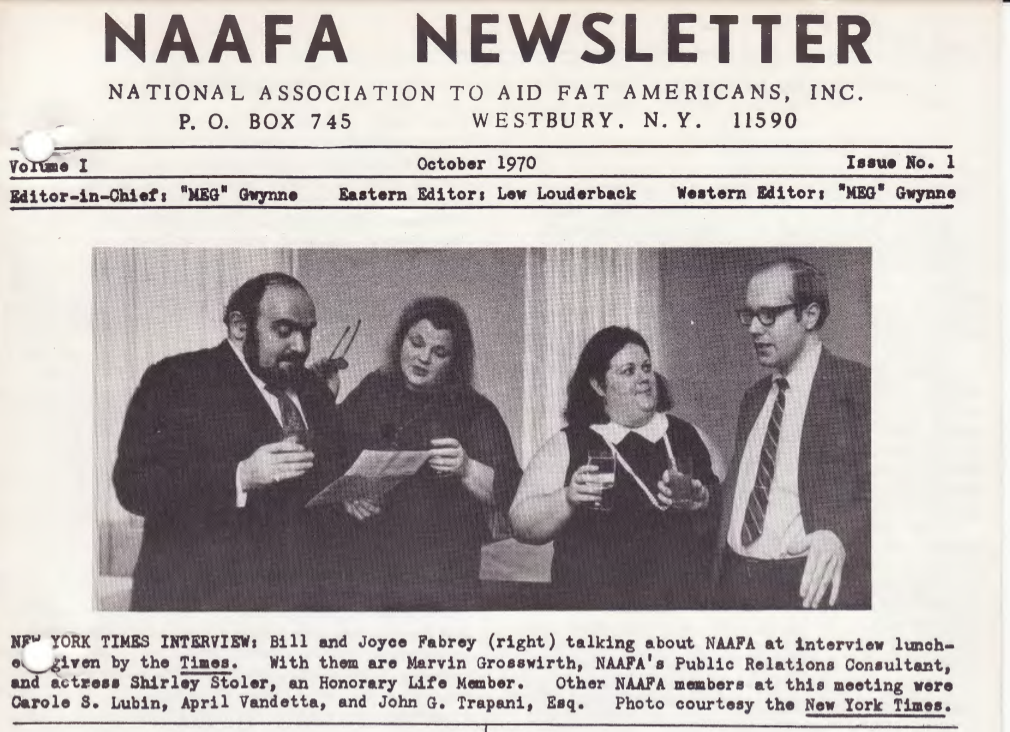NAAFA’s Origin Story & Fat Activism History
It all started when…
In 1969, a young engineer in New York named Bill Fabrey was very angry about the way the world was treating his fat wife, Joyce. He had read an article in the Saturday Evening Post by Lew Louderbach, who wrote anti-fatness in US culture and explained how he and his wife, Ann, had become “refugees from the insanity of dieting.” Bill made copies of the article and handed them out to everyone he knew. Then, with Lew’s help, he gathered a small group of people and created the National Association to Aid Fat Americans (today known as the National Association to Advance Fat Acceptance). The group named him as the founder and voted for him as the first Board Chair.
[Watch: 5 Decades & Counting: Thoughts on the Past, Present & Future of Fat Acceptance with Bill Fabrey]
On the other side of the U.S. a group of California feminists were also angry about the treatment of fat people. Some of them joined NAAFA, but they didn’t find NAAfA radical enough. They formed the Fat Underground. What NAAFA called Fat Acceptance, they called Fat Liberation. By 1973 they had released their ground-breaking Fat Liberation Manifesto. It demanded “equal rights for fat people in all areas of life.” It also called out the “reducing” industries (aka diet culture) and declared them enemies. Other fat feminist collectives, notably those in New Haven and Boston, worked alongside the Fat Underground to push the boundaries of the growing fat activist movement and to demand fat women’s inclusion in feminist spaces.
A black and white photo showing seven fat women from the Fat Underground. The photo is a still taken from the Fat Underground video released in 1979 (available on YouTube].
[Watch: 1979 Fat Underground Video by Marge Dean, including footage shot in 1975 by Shirl Buss. Posted on YouTube by CC.]
(Content warning: video includes discussion of extreme anti-fatness, descriptions of sexual assault, and historical images that depict white supremacy and violence against women)
NAAFA Goes NATIONAL and FAT ACTIVISM GOES GLOBAL
The fat rights movement continued to grow, and NAAFA began to form chapters across the country. NAAFA also began to hold national conventions, which became the first places many people encountered the fat fashion shows, fat pool parties, and fat dance parties that are now run by many influencers, organizations, and companies.
In the ‘70s, ‘80s and ‘90s, fat activists could be spotted on daytime talk shows and in other media, arguing that the diet industry was a scam. By the 90’s, fat activists were picketing in front of the White House, staging protests in front of gyms with fatphobic advertising, and dancing alongside floats in San Francisco’s Pride parade. By the 1980’s, enthusiasm for fat liberation was beginning to spread further across the globe. The London Fat Women’s Group was formed in the mid-80’s and was active for years.
In the late 90’s and early 2000’s, as NAAFA celebrated it’s 25th Anniversary, the internet was one of the main places where body shame and body love were spread. As ‘90s message boards and chat rooms gave way to social media, fat people who had first found community in activism continued to build that digitally. Fat activists moved from AOL groups and NAAFA’s online forums to Tumblr and Instagram. Hashtags and Facebook groups helped people connect in new ways. A new generation was spreading vibes known as “body positivity.”
Today, NAAFA is the world’s longest-running organization working for #EqualityAtEverySize. We are committed to an intersectional approach to fat activism, and we work in partnership with many other fat liberation organizations and projects in pursuit of our vision of a culture where all fat people are free, celebrated, and liberated from every form of oppression.


![A black and white photo showing seven fat women from the Fat Underground. The photo is a still taken from the Fat Underground video released in 1979 (available on YouTube].](https://images.squarespace-cdn.com/content/v1/5e7be2c55ceb261b71eadde2/1634329494022-FAIJV984X2WC9ZPHA1JS/fat+underground.jpg)